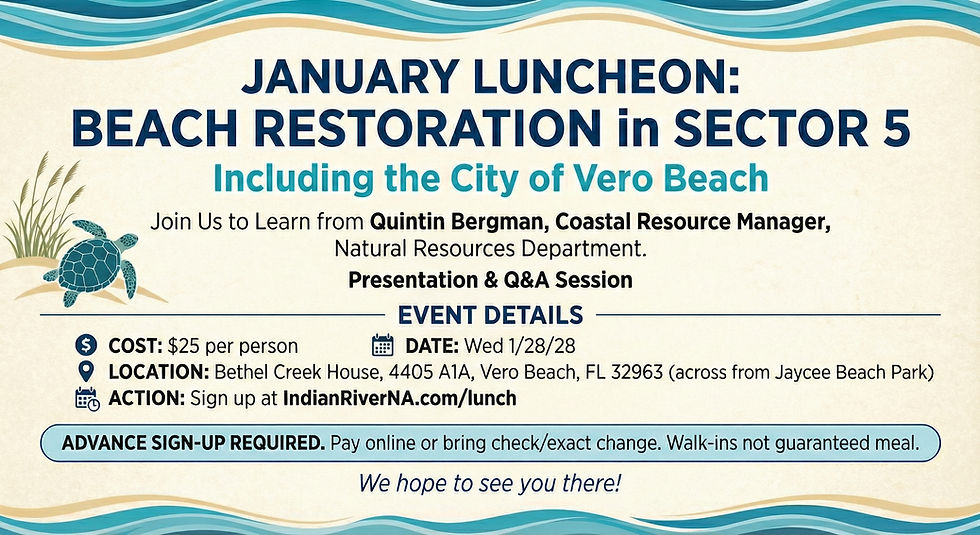Recycling: Past and Present
- IRNA

- Dec 12, 2020
- 3 min read
By Sharon Gorry
1950’s Indian River County Recycling wasn’t an issue. Tripson Dairy delivered milk, orange juice, and just about anything we needed in glass bottles which, when empty, they collected at the next delivery. Coke, Mr. Pib, Root Beer, any type of beverage (a treat for sure) came in glass bottles which could be returned to the store for a refund of the 2 cent deposit charged at the time of purchase. It was not uncommon to see kids collecting bottles in their wagon and pulling it to the nearest grocer to collect the spoils for a candy bar or bubble gum treat. What an incentive. We did not have plastic or Styrofoam disposable plates and cups. It was all paper plates, paper cups (waxed), and paper straws. Groceries came home in brown paper bags that were used for household garbage (taken out every night) as well as repurposed as schoolbook covers. Essentially, no waste!
Fast forward to today We see pictures of floating plastic islands in the ocean. The Great Pacific Garbage Patch in the Pacific Ocean is over 61,000 square miles, an area twice the size of Texas.
So what can we do? REDUCE our reliance on items that are prepackaged and single-use plastic. Take your own bags to the grocery. Use permanent water bottles that you can refill.
Here is a list of what NOT to put in your recycling bin:
Electronics, hoses, Pyrex cookware, Styrofoam, six pack rings, plastic bags, clothing, rubber items, ceramics, shrink wrap, loose plastic bottle caps, candles with wax and window glass.
Shredded paper: The new processor will not accept shredded paper as a recyclable item because the small pieces fall through their conveyors and end up going into the landfill.
Batteries: Batteries should NOT be placed in the recycling cart.
Loose plastic film: including plastic shopping bags, bread bags, dry cleaning and newspaper bags can NEVER be put in the blue cart.
Used cooking oil: should never be put down the drain, instead it can now be recycled at one of the five Customer Convenience Centers or the Landfill.
Many items not recyclable in the blue carts can be recycled at the county’s five Customer Convenience Centers and main County Landfill. Learn more about these locations here: https://www.ircrecycles.com/Convenience_Centers.htm
Don’t flush outdated medicines down the drain. Take them to one of the two locations in Indian River County that have a Medicine Disposal Dropbox: The IRC Sheriff’s Office at 4055 41st St, Vero Beach and Walgreen’s at 1705 US1, Vero Beach
Keep items out of our landfill by donating unwanted appliances, furniture, linens, housewares, toys, and clothing to organizations that help the less fortunate. A few who have pick up service are:
Salvation Army Thrift Store: 772-563-0560 Habitat for Humanity: 772-257-0222 Goodwill Vero Beach: 772-770-3330 Goodwill Oslo Store: 772-564-8668
Plastics are now used more than most man-made materials and have long been under environmental scrutiny. However, robust global information, particularly about their end-of-life fate, is lacking. By identifying and synthesizing dispersed data on production, use, and end-of-life management of polymer resins, synthetic fibers, and additives, we present the first global analysis of all mass-produced plastics ever manufactured. We estimate that 8300 million metric tons (Mt) of virgin plastics have been produced to date. As of 2015, approximately 6300 Mt of plastic waste had been generated, around 9% of which had been recycled, 12% was incinerated, and 79% was accumulated in landfills or the natural environment. If current production and waste management trends continue, roughly 12,000 Mt of plastic waste will be in landfills or in the natural environment by 2050.
Plastic pollution is a planetary threat, affecting nearly every marine and freshwater ecosystem. In response, multilevel mitigation strategies are being adopted, but these so far lack quantitative assessment of how they reduce plastic waste. We assessed the impact of three broad management strategies, plastic waste reduction, waste management, and environmental recovery, at different levels of effort to estimate plastic pollution to 2030 for 173 countries. We estimate that 19 to 23 million Mt, or 11%, of plastic waste generated globally in 2016 entered aquatic ecosystems. Considering the ambitious commitments currently set by governments, annual pollution may reach up to 53 million metric tons per year by 2030. To reduce pollution to a level well below this prediction, extraordinary efforts to transform the global plastics economy are needed.




Comments